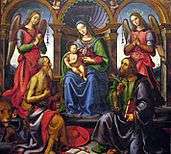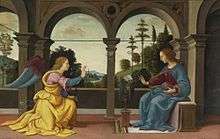Raffaellino del Garbo
| Raffaellino del Garbo | |
|---|---|
 Cristoforo Coriolano's portrait of Raffaellino del Garbo, from the 1568 edition of Vasari's Vite. | |
| Born |
1466–1476 Florence, Italy |
| Died |
ca. 1527 Florence, Italy |
| Nationality | Italian |
| Education | Filippino Lippi |
| Known for | Painting |
| Movement | Renaissance |
Raffaellino del Garbo (1466 or perhaps 1476 – 1527) was a Florentine painter of the early Renaissance.
Biography

His real name was Raffaello Capponi; "del Garbo" was a nickname, bestowed upon him seemingly from the graceful nicety (garbo) of his earlier works. He has also been called Raffaello de Florentia, and Raffaello de Carolis or Karli. He was a pupil of Filippino Lippi, with whom he remained till 1490, if not later. He accompanied Filippino to Rome, where he painted the ceiling of the chapel of St. Thomas Aquinas (Caraffa Chapel) in the church of Santa Maria sopra Minerva.
Vasari thought the artist had died at Florence in 1524. This was evidently a case of mistaken identity, since he was listed as fit for military duty in 1527. Raffaelino probably succumbed during the plague that ravaged Florence during 1527 to 1528.[1]
Works
Among his works are a Resurrection, originally for the church of the Benedictine monastery of Monte Oliveto, now in the Galleria dell'Accademia. He painted a Miracle of the Loaves in the refectory of the convent at Cesto. A Coronation of the Virgin is in the Louvre museum. A Madonna and child with Saints and donors was previously at the Berlin Museum. Another picture painted in the early part of his life is in the monastery of San Salvi, and is highly commended by Moreni in his Notizie istoriclie dei Contorni di Firenze. He painted a Virgin and Child between SS. Francis and Zenobius and two kneeling patrons, which is (1500, and is in the Hospital of Santa Maria Nuova, in Florence. He married and had a large family. The cares of a large family eventually proved fatal to the growing reputation of Capponi, causing him to sink into a state of listlessness and apathy. The young Bronzino was his pupil.
- Portraits
 Portrait of a man
Portrait of a man Saint John the Baptist
Saint John the Baptist Bust of a Young Woman
Bust of a Young Woman Vivaldo da San Gimignano
Vivaldo da San Gimignano
- Religious works
 Madonna Enthroned with Saints and Angels (1502), Oil on poplar panel, 214.6 × 198.1 cm, Fine Arts Museums of San Francisco, Gift of the Samuel H. Kress Foundation
Madonna Enthroned with Saints and Angels (1502), Oil on poplar panel, 214.6 × 198.1 cm, Fine Arts Museums of San Francisco, Gift of the Samuel H. Kress Foundation

References
- ↑ Waldman, Louis (2006). "Raffaellino del Garbo and His World: Commissions, Patrons, Associates". Artibus et Historiae. 27 (54): 51–94. doi:10.2307/20067123. JSTOR 20067123.

- Bryan, Michael (1886). Robert Edmund Graves, ed. Dictionary of Painters and Engravers, Biographical and Critical (Volume I: A-K). York St. #4, Covent Garden, London; Original from Fogg Library, Digitized May 18, 2007: George Bell and Sons. p. 230.
Further reading
- Zeri, F. & Gardner, E. (1971). Italian Paintings: A Catalogue of the Collection of The Metropolitan Museum of Art: Florentine School. New York: The Metropolitan Museum of Art. (pages 172-174)
External links
| Wikimedia Commons has media related to Raffaellino del Garbo. |